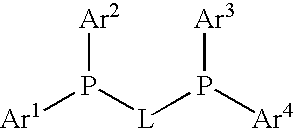Process for preparing arylamines
a technology of arylamines and arylamines, applied in the field of preparing arylamines or heteroarylamines or arylamides or heteroarylamides, to achieve the effect of widening the range of us
- Summary
- Abstract
- Description
- Claims
- Application Information
AI Technical Summary
Problems solved by technology
Method used
Image
Examples
example 1
Coupling of 3-methylpiperidine with 4-bromobenzotrlfluoride(4-bromotrifluoromethylbenzene) (catalyst: Pd(OAc)2 / 2,2-dimethyl-1,3-bis(di-phenylphosphino)propane)
[0044]5.8 g of sodium t-butoxide (60.1 mmol), 5.2 g of 3-methylpiperidine (52.6 mmol) and 8.5 g of 4-bromobenzotrifluoride (37.6 mmol) are dissolved or suspended in 50 ml of dioxane and admixed at 80° C. with a suspension of 0.167 g of palladium(II) acetate (2 mol %) and 0.43 g of 2,2-dimethyl-1,3-bis(diphenylphosphino)propane (2.5 mol %). The mixture is subsequently refluxed and the conversion is monitored by HPLC. After about 4 hours, the conversion is >98%. The work-up is carried out by addition of water to dissolve the precipitated salts, addition of toluene and phase separation. The upper, product-containing phase is evaporated on a rotary evaporator and the product is purified by chromatography. This gives 7.5 g (82%) of coupling product (3-methyl-1-(4-trifluoromethylphenyl)piperidine).
example 2
Coupling of 3-methylpiperidine with 4-bromobenzotrifluoride (catalyst: Pd(dba)2 / 2,2-dimethyl-1,3-bis(diphenylphosphino)propane)
[0045]As example 1 but using 0.40 g of bis(dibenzylideneacetone)palladium(0) instead of 0.167 g of palladium(II) acetate. As in example 1, the reaction was concluded after a short reaction time (in this case boiling overnight). Yield: 7.8 g (84%)
example 3
Coupling of 3-methylpiperidine with 4-chlorobenzotdifluoride (catalyst: Pd(OAc)2 / 2,2-dimethyl-1,3-bis(diphenylphosphino)propane)
[0046]As example 1 but using 6.7 g of 4-chlorobenzotrifluoride (37.6 mmol) instead of 8.5 g of 4-bromobenzotrifluoride (37.6 mmol). To achieve complete conversion (>95%), boiling had to be continued for a somewhat long time (60 h) when using the less reactive chloro compound. However, the yield was comparable with that in the two previous examples (7.1 g, 78%).
PUM
| Property | Measurement | Unit |
|---|---|---|
| temperature | aaaaa | aaaaa |
| molar ratio | aaaaa | aaaaa |
| molar ratio | aaaaa | aaaaa |
Abstract
Description
Claims
Application Information
 Login to View More
Login to View More - R&D
- Intellectual Property
- Life Sciences
- Materials
- Tech Scout
- Unparalleled Data Quality
- Higher Quality Content
- 60% Fewer Hallucinations
Browse by: Latest US Patents, China's latest patents, Technical Efficacy Thesaurus, Application Domain, Technology Topic, Popular Technical Reports.
© 2025 PatSnap. All rights reserved.Legal|Privacy policy|Modern Slavery Act Transparency Statement|Sitemap|About US| Contact US: help@patsnap.com



